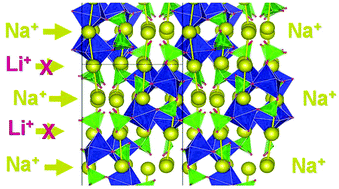Selective sodium intercalation into sodium nickel–manganese sulfate for dual Na–Li-ion batteries
Abstract
Double sodium transition metal sulfates combine in themselves unique intercalation properties with eco-compatible compositions – a specific feature that makes them attractive electrode materials for lithium and sodium ion batteries. Herein, we examine the intercalation properties of novel double sodium nickel–manganese sulfate, Na2Ni1/2Mn1/2(SO4)2, having a large monoclinic unit cell, through electrochemical and ex situ diffraction and spectroscopic methods. The sulfate salt Na2Ni1/2Mn1/2(SO4)2 is prepared by thermal dehydration of the corresponding hydrate salt Na2Ni1/2Mn1/2(SO4)2·4H2O having a blödite structure. The intercalation reactions on Na2Ni1−xMnx(SO4)2 are studied in two model cells: half-ion cell versus Li metal anode and full-ion cell versus Li4Ti5O12 anode by using lithium (LiPF6 dissolved in EC/DMC) and sodium electrolytes (NaPF6 dissolved in EC:DEC). Based on ex situ XRD and TEM analysis, it is found that sodium intercalation into Na2Ni1/2Mn1/2(SO4)2 takes place via phase separation into the Ni-rich monoclinic phase and Mn-rich alluaudite phase. The redox reactions involving participation of manganese and titanium ions are monitored by ex situ EPR spectroscopy. It has been demonstrated that manganese ions from the sulfate salt are participating in the electrochemical reaction, while the nickel ions remain intact. As a result, a reversible capacity of about 65 mA h g−1 is reached. The selective intercalation properties determine sodium nickel–manganese sulfate as a new electrode material for hybrid lithium–sodium ion batteries that is thought to combine the advantages of individual lithium and sodium batteries.



 Please wait while we load your content...
Please wait while we load your content...